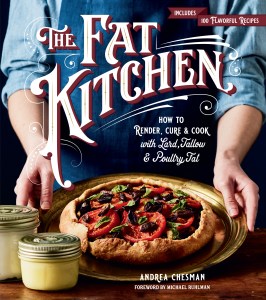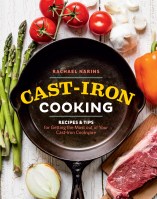For Better Latkes, Rethink Your Cooking Fat
If you like your latkes to be more than just a vehicle for grease, author Andrea Chesman says it’s time to do away with vegetable oil.

Break out the latkes: Hanukkah is coming. For most people, said latkes — grayish, greasy potato pancakes slathered with sour cream and applesauce — are beloved just because they are reminders of home and childhood. But what if your latkes didn’t have to be mere vehicles for oil and nostalgia? What if they could be brown on the outside, snowy white on the inside, and not at all greasy? I’m here to help you make your latkes perfect.
The Jewish holiday of Hanukkah — the festival of lights — is observed for eight nights. It commemorates and celebrates the miracle that occurred after the destruction of the Temple in Jerusalem, when the flame of the eternal lamp burned for eight days, even though there was only enough oil to last one day. The holiday is traditional celebrated with candle lighting, games, gifts, and eating fried foods.

Back in the old country, geese were the poultry of choice, prized for their down, rich meat, and copious amounts of fat. They were also practical birds to raise in Eastern Europe because they could thrive on forage and didn’t need shelter from the cold weather. This was the time of year when a goose would be slaughtered to provide the cooking oil, and the hope was that the goose fat would last long enough to make matzoh balls for the Passover celebration in the spring.

These days, most Americans fry their potato pancakes in vegetable oil, even though chicken fat (schmaltz) or lard is readily available. This recipe change happened sometime in the 1900s, when polyunsaturated vegetable seed oils were touted as “heart healthy.” This myth is more than adequately debunked by Nina Teicholz in The Big Fat Surprise, among others.
Not only are the health claims untrue, but vegetable oil has a way of being absorbed into the potatoes, giving latkes that heavy greasiness, in a way that animal fat doesn’t.

So scratch the idea that vegetable oil frying is better for you than frying in animal fat. This year, fry your potato pancakes in any rendered animal fat you can get your hands on. You can find information on how to render fat in my book The Fat Kitchen. And making the interior of the latke snowy white is as simple as could be. Before forming your pancakes, put the grated potatoes in a bowl of acidulated water (1 tablespoon of lemon juice or vinegar to 4 cups water) and give them a swish to wash away the starch, which causes browning. Drain well.
Potato Latkes
Latkes are often mistreated in the kitchen, and the result is a greasy pancake, gray on the inside, soggy throughout. The perfect latke is crisp on the outside, tender and snowy white on the inside. There are a few extra steps in my recipe as part of my never-ending quest to get this dish right. Most important is the frying medium. It wasn’t until I switched from a vegetable seed oil to a poultry fat — as my ancestors used — that the pancakes stopped being greasy.
Serves 4–6
Ingredients
- 3 pounds russet or other baking potatoes, peeled
- 1 large onion
- Fresh lemon juice or distilled white vinegar, as needed
- 2 eggs, lightly beaten
- 2 teaspoons fine sea salt
- ¼ teaspoon freshly ground black pepper
- ¼ cup (1.7 ounces/50 g) any poultry fat (goose fat is traditional)
- Applesauce, for serving
- Sour cream, for serving
Directions
Coarsely grate the potatoes and onion with a box grater or in a food processor.
Transfer the potato mixture to a large bowl filled with acidulated water (1 tablespoon lemon juice or vinegar to 4 cups water). Swish around with your hands for 1 minute. Pour into a strainer and drain well. Place a clean kitchen towel on the counter. Dump the potatoes onto the towel and pat dry. This step will keep the potatoes from turning pink, then gray, as they are exposed to air.
In the food processor, pulse half of the potato mixture until finely chopped but not puréed. Combine the grated and finely chopped potatoes in a large bowl and add the eggs, salt, and pepper. Mix well.
Preheat the oven to 200° F. Line a half sheet pan with wire racks.
Heat the fat in a large skillet over medium-high heat. (If your skillet is less than 12 inches in diameter, start with half the poultry fat and add more as needed as you make more batches.) Working in batches, drop the potato mixture into the hot fat, ¼ cup at a time, and fry until golden on the bottom, 2 to 3 minutes. Place the latkes on the prepared sheet pan and put the sheet pan in the oven to keep warm. Continue making latkes until all the batter is used.
Serve as soon as possible. Pass the applesauce and sour cream at the table.
Recipe excerpted from The Fat Kitchen © 2018 by Andrea Chesman. All rights reserved.
The Fat Kitchen is the comprehensive guide to rendering and using whole animal fats, including lard, tallow, and poultry fat. Cooks will learn the distinctive qualities and best uses of each fat along with methods for curing and storing them. In addition, 100 scrumptious recipes highlight traditional cultural favorites like matzoh ball soup, pasta carbonara, pork tamales, roast beef with Yorkshire pudding, Southern-style collards, confit chicken, New England baked beans, and jelly doughnuts.











